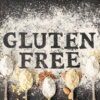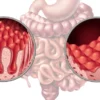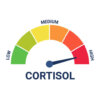
Pancolitis is where there is inflammation throughout the entire colon (the large intestine). This impacts approximately 20-40% of those with the inflammatory bowel disease (IBD) Ulcerative colitis.
Pancolitis is associated with a more severe form of Ulcerative colitis. It is more common for those with pancolitis to require surgery to have part or all of their large intestine removed. Of all of those with pancolitis, approximately 40% will require the removal of their entire colon. It is also more common for colorectal cancer to appear in this population. [Source: Pubmed]
Pancolitis is understood to be a subtype of Ulcerative colitis. In many cases of Ulcerative colitis symptoms relapse and then remit. This is where symptoms flare up for a period (relapse) and then calm down again (remit). However, in pancolitis approximately one-third experience a chronic unremitting form of the condition.
This can be where remission of the disease isn’t achieved with medications. It can also be that the patient is dependent on medications. While the IBD medications may have helped to a degree, symptoms can still appear regularly. [Source: Pubmed]
What are the symptoms of pancolitis?
The most common digestive symptoms in someone with pancolitis are the same as Ulcerative Colitis and include:
- Bloody diarrhoea (with or without mucus)
- Rectal urgency
- Abdominal pain (that is often relieved with bowel movements)
- Tenesmus (the urge to pass a stool even when bowels are empty) [Source: Pubmed]
Those with pancolitis are also more likely to experience symptoms outside of the digestive tract. These are symptoms such as arthritis (inflammation in the joints) and uveitis (inflammation of the eye). These are less common in those with milder forms of Ulcerative colitis. [Source: Pubmed]
As already described, patients can experience periods of being symptom-free. For some, this is followed by a flare-up in symptoms. One of the greatest predictors of a flare in symptoms is the level of inflammation in the large intestine.
One study reported those with a clinically inactive condition have a 20% chance of a flare-up in the next 12 months. However, those with an active form of the disease (where inflammation is present) can have a 70% chance of a flare-up over the same time period. [Source: Pubmed]

What causes pancolitis?
Pancolitis is understood to be a more severe form of Ulcerative colitis. While a single cause for Ulcerative Colitis is not known, it’s understood to result from a combination of factors.
These risk factors are:
Age and gender: There are increased risk factors between 2-time points in someone’s life. These are between 20 and 30 years of and between 50 and 80 years of age. While not conclusive, some research has indicated an increased prevalence in males. [Source: Science Direct]
Race and ethnicity: Those of Jewish heritage have a 3-fold higher risk of developing Ulcerative Colitis when compared to non-Jews. Also, within the Jewish population, Ashkenazi Jews have a higher prevalence compared to the Sephardim, American and European Jewish populations [Source: Pubmed]
Genetics: About 8-14% of those with a diagnosis of Ulcerative Colitis have a family history of IBD. Alterations in specific genes have been reported which are understood to be central to this increase [Source: Pubmed].
Smoking: While the risk of Crohn’s disease increases in those who smoke, in Ulcerative Colitis the risk of developing the condition actually increases when individuals stop smoking. Studies have shown that current smoking leads to a later onset of the disease, milder inflammation and a reduced need for immunosuppression medication and surgery [Source: Pubmed].
There are also several factors that increase the chance of left-sided colitis progressing to pancolitis. The most significant risk factor is the severity of the inflammation at the early stage of the condition. Those with more severe inflammation are 14.8 times more likely to experience disease progression when compared to those with milder inflammation.
Those diagnosed with left-sided colitis are 2.5% more likely to develop pancolitis that those who we originally diagnosed with proctitis. [Source: Pubmed]
Factors than are associated with an increased risk of disease progress include:
- The presence of joint symptoms (i.e. arthritis)
- The extent of the disease at the time of diagnosis, particularly left-sided colitis
- Severity of bleeding
- Younger age at the time of diagnosis [Source: Pubmed]
Is pancolitis serious?
Due to several factors, pancolitis is seen as a more severe form of Inflammatory bowel disease. This can be due to the inflammation being present in the entire colon. It’s also common for levels of inflammation to be higher.
Those with pancolitis are more likely to require surgery to remove part of all of their large intestine. In addition to this, pancolitis can also increase the risk of developing colon cancer.
Can pancolitis cause bowel cancer?
Patients diagnosed with pancolitis are at an increased risk of developing colorectal cancer. This does not mean that everyone with pancolitis will then develop bowel cancer.
There are 2 factors that increase the risk of someone with pancolitis then going on to develop bowel cancer. These include:
- Young age at the time of diagnosis
- The extent of the disease (i.e. the severity of the inflammation)
Studies have indicated that the risk was highest in those who were diagnosed when they were under 15 years of age. It was also noted that those diagnosed with proctitis or left-sided colitis after the age of 30 do not have a substantially increased risk. The risk of bowel cancer was also equal between men and women.
Effective treatment however has been shown to reduce the risk of this complication. [Source: Pubmed]
What is the gut microbiome?
The digestive tract is the home to a wide array of microorganisms. These include bacteria, viruses and fungal species. These organisms support a wide range of beneficial processes which support gut health.
2 of the key benefits of these organisms include:
- Supporting the health of the gut lining
- Supporting the immune system within the gut
Imbalances in these organisms can lead to a disruption of both of these processes and further impact both digestive function and human health. Imbalances in these organisms is referred to as dysbiosis. This indicates not only an imbalance of the organisms but also an alteration in their function. Dysbiosis has been seen in inflammatory bowel diseases such as Ulcerative colitis.
While it is not fully understood if dysbiosis is the cause or the result of the disease it may contribute to the ongoing nature of symptoms. This can be due to the impaired ability of the gut microbiome to support the gut lining and the immune system within the gut. [Source: Pubmed]
The balance of the gut microbiome is associated with several factors of IBD. The imbalances can reflect the severity of the condition as well as remission and flare-up responses. Specific changes in the gut microbes of those with Ulcerative colitis have been reported. This is characterised by lower levels of beneficial bacteria that can lower inflammation and increase numbers that promote inflammation.
In addition to these specific changes, a reduction in the diversity of the microbiome has also been noted. This is understood to indicate that the microbiome is less stable and less resilient. [Source: Pubmed]
Gut health and pancolitis
Research into the balance of the gut microbiome shows differences between patients with an active form of pancolitis versus when they’re in remission.
In those with the active disease, there was an increase in Proteobacteria (particularly Bilophila) and Fusobacterium. This was distinctly different to those with the disease in remission or those without any form of inflammatory bowel disease.
Those in remission or without inflammatory bowel disease were reported to have similarities in their gut microbiome. This included a higher proportion of Firmicutes Faecalibacterium and Roseburia. All of which are considered to be beneficial for gut health. [Source: Pubmed]
One species of bacteria with a wide range of gut benefits is Faecalibacterium. They support many processes within the gut that include:
- metabolize certain foods that promote colonic motility
- supporting a balanced immune system is the gut
- supporting anti-inflammatory properties [Source: Pubmed]
A reduced number of these organisms have been associated with an increased risk of a flare in gut symptoms with higher levels being associated with a reduced disease state. This has led some to suggest that this organism can be used as a potential marker for disease activity in IBD [Source: Pubmed].
Levels of Bilophila (a subset of the Proteobacteria family of bacteria) can be elevated in active pancolitis. These organisms are often elevated in individuals who eat a diet rich in saturated fats. This had led some to suggest that a reduction in saturated fat consumption may modify and improve the progression of pancolitis.
An increase in Bilophila in the gut may also be responsible for the initial onset of symptoms. This is due to the ability of Bilophila to promote the imbalanced immune response in the gut that leads to inflammation.
Other dietary patterns that may influence disease state in pancolitis are excessive consultation of wheat products, fried foods and dairy products. This has been associated with the development of severe diarrhoea in those with active pancolitis. [Source: Pubmed]

How to rebalance the gut bacteria
Gut dysbiosis is the term used to describe an imbalance in the gut microbiome. Supporting the balance of the microbiome is a central consideration in improving gut health and gut symptoms.
Rather than it being a single food that directly leads to dysbiosis, it’s understood that it’s more to do with long-term dietary patterns. In particular, the Western diet has been associated with gut imbalances. This type of diet involves low levels of dietary fibre (i.e. low levels of fruits and vegetables) alongside the consumption of processed foods high in fat and sugar.
Due to the role of dietary fibres in supporting the growth of beneficial bacteria in the gut, a low intake of fibre can effectively starve the good bacteria. This has a negative effect on the gut microbiome. [Source: Pubmed]
The challenge in inflammatory bowel diseases is that due to the irritation and inflammation within the gut, higher fibre foods are not well tolerated. This is where addressing the underlying imbalances in the gut with targeted supplements can be a key element of a gut health support process.
However, a dietary template that can be used in the short term for inflammatory bowel is called the IBD-AID. This is a template and approaches food in 4 phases.
These phases are:
- Phase 1 – Soft, well-cooked or cooked then pureed foods with no seeds
- Phase 2 – Soft Textures: This includes well-cooked or pureed foods with no seeds. It’s best to choose very soft or tender foods
- Phase 3 – The diversity of the diet is increased but patients may still need to avoid stems and still focus on softer/more well-cooked vegetables.
- Phase 4 – A maintenance phase for that individual
Once inflamed, the gut lining becomes very sensitive. This leads to high-fibre foods being too rough for the gut. This dietary approach takes this into consideration. Phase 1 is low in fibre with all foods pureed and as symptoms calm the stages are worked through, gradually relaxing and expanding the diet [Source: Pubmed].
Also Read: How To restore Healthy Gut Flora
Supplements and Pancolitis
Certain supplements have been researched to help support and balance the gut.
Probiotics supplements have been shown to help maintain longer periods of remission and also reduce the risk of a flare-up.
A specific probiotic supplement called VSL#3 was studied in Ulcerative colitis patients who were not responding to conventional medical approaches. This led to a remission/response rate of 77% of the patients prescribed the probiotic with no adverse reactions reported. [Source: Pubmed]
Vitamin D is a nutrient that supports the immune system and inflammation in the body. A study has found that normalising the levels of patients with a vitamin D deficiency can improve quality of life and reduce disease activity. [Source: Pubmed]
Curcumin is a concentrated form of turmeric. This has anti-inflammatory properties that have been studied in regard to inflammatory bowel diseases. This has been found to induce and maintain remission rates in these diseases [Source: Pubmed]
Butyric acid is an important energy source for the cells that line the digestive tract. This supports levels of inflammation and also supports cell regeneration. Taking this as a supplement has been indicated to reduce inflammation in ulcerative colitis. Certain foods such as oat bran naturally support the body’s own production of butyric acid which has been indicated to support remission rates. [Source: Pubmed, Pubmed]
Conclusion
Even within a specific diagnosis, there can be varying levels of severity. This means that a personalised approach can be required to address the variety of factors that may influence gut health and bacterial balance. This is particularly true in pancolitis which has a high risk of requiring surgery.
Supporting the underlying reasons in the gut for symptoms developing can be an important way to approach this condition holistically. This involves the use of dietary adjustments, targeted supplements, and further testing.
Working with a trained practitioner can help guide this process and offer the most comprehensive approach to gut health.






